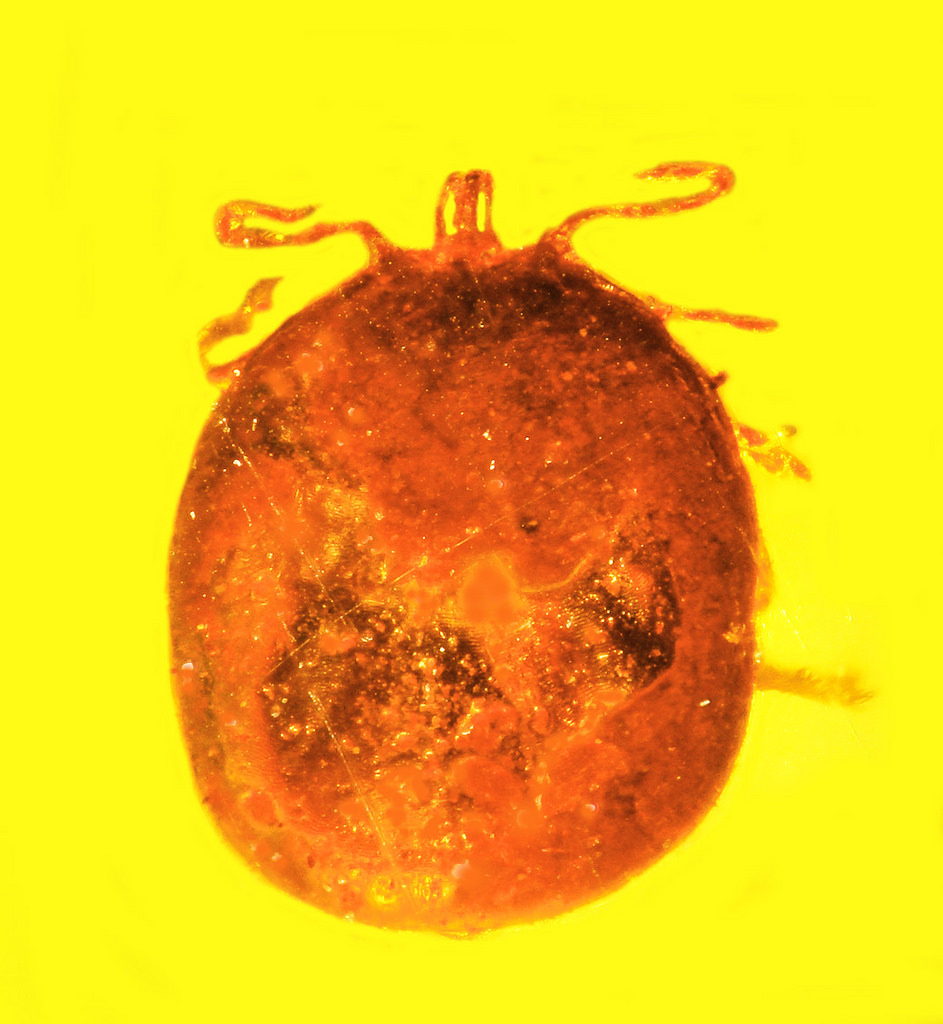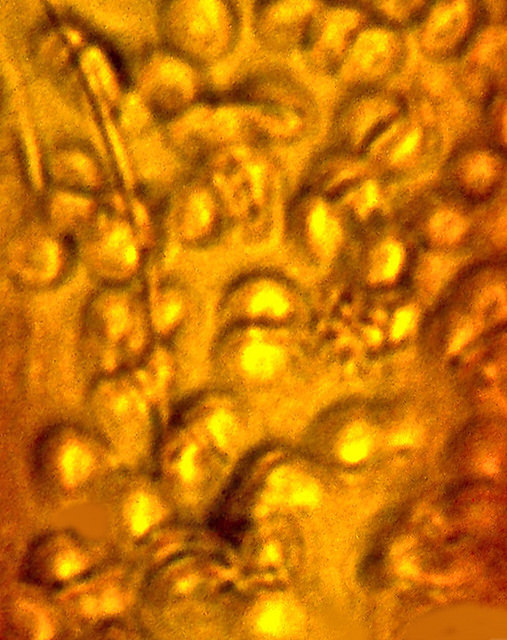It looks like you're using an Ad Blocker.
Please white-list or disable AboveTopSecret.com in your ad-blocking tool.
Thank you.
Some features of ATS will be disabled while you continue to use an ad-blocker.
16
share:
About 30 million years ago two monkeys sat grooming each other in a tree , a Tic was discovered removed and dropped to the ground but before it could
hit the ground it landed in tree sap , 30 million years later the Tick has reemerged to be described as a "remarkable new find" encased in an amber
time capsule.
In itself the Tic is unremarkable but its removal by the grooming monkey punctured the Tic's body so exposing its freshly obtained blood meal giving us the first Red Blood Cells from a Mammal living in prehistoric times.
Picture of the engorged Tic with the exposed blood on its back.

Close up of the 30 million year old blood cells

It's a moment in time captured by nature as a gift to the future.
In itself the Tic is unremarkable but its removal by the grooming monkey punctured the Tic's body so exposing its freshly obtained blood meal giving us the first Red Blood Cells from a Mammal living in prehistoric times.
Picture of the engorged Tic with the exposed blood on its back.

Two small holes in the back of a blood-engorged tick, which allowed blood to ooze out just as the tick became stuck in tree sap that later fossilized into amber, provide a brief glimpse of life in a tropical jungle millions of years ago in what is now the Dominican Republic.
“These two tiny holes indicate that something picked a tick off the mammal it was feeding on, puncturing it in the process and dropping it immediately into tree sap,” said George Poinar, Jr., professor emeritus in the College of Science at Oregon State University, author of the study and an international expert on plant and animal life forms found preserved in amber.
“This would be consistent with the grooming behavior of monkeys that we know lived at that time in this region. The fossilized blood cells, infected with these parasites, are simply amazing in their detail. This discovery provides the only known fossils of Babesia-type pathogens.”
Close up of the 30 million year old blood cells

Part of what makes these fossils unique, Poinar said, is the clarity by which the parasites and blood cells are preserved, almost as if they had been stained and otherwise treated in a laboratory for inspection. The parasites were different enough in texture and density to stand out clearly within the red blood cells during the natural embalming process for which amber is famous.
oregonstate.edu...
It's a moment in time captured by nature as a gift to the future.
originally posted by: gortex
About 30 million years ago two monkeys sat grooming each other in a tree , a Tic was discovered removed and dropped to the ground but before it could hit the ground it landed in tree sap , 30 million years later the Tick has reemerged to be described as a "remarkable new find" encased in an amber time capsule.
In itself the Tic is unremarkable but its removal by the grooming monkey punctured the Tic's body so exposing its freshly obtained blood meal giving us the first Red Blood Cells from a Mammal living in prehistoric times.
Picture of the engorged Tic with the exposed blood on its back.
Two small holes in the back of a blood-engorged tick, which allowed blood to ooze out just as the tick became stuck in tree sap that later fossilized into amber, provide a brief glimpse of life in a tropical jungle millions of years ago in what is now the Dominican Republic.
“These two tiny holes indicate that something picked a tick off the mammal it was feeding on, puncturing it in the process and dropping it immediately into tree sap,” said George Poinar, Jr., professor emeritus in the College of Science at Oregon State University, author of the study and an international expert on plant and animal life forms found preserved in amber.
“This would be consistent with the grooming behavior of monkeys that we know lived at that time in this region. The fossilized blood cells, infected with these parasites, are simply amazing in their detail. This discovery provides the only known fossils of Babesia-type pathogens.”
Close up of the 30 million year old blood cells
Part of what makes these fossils unique, Poinar said, is the clarity by which the parasites and blood cells are preserved, almost as if they had been stained and otherwise treated in a laboratory for inspection. The parasites were different enough in texture and density to stand out clearly within the red blood cells during the natural embalming process for which amber is famous.
oregonstate.edu...
It's a moment in time captured by nature as a gift to the future.
Cool find! I am wondering how 2 tiny holes indicate this tick being picked off another mammal. Is that a specific characteristic of bugs picked off by monkeys? Really just wondering because the scientist claims this is what happened.
if it wasn't punctured could it have been a fresh red blood cell time capsule?
originally posted by: gortex
a reply to: Vasa Croe
George Poinar says it's consistent with the grooming , don't know if there's evidence for that but I suppose it explains how the Tic came to be in the amber with the two puncture in its body.
I think it's a likely scenario.
Yeah, that's what I mean. I am just wondering how these 2 tiny holes are indicative of that.
On another note....instead of burial or cremation, I am totally going to get stuffed in a 55 gallon drum and have tree sap poured all around me....simply because I think it would be cool if a scientist found me perfectly preserved 20 million years from now and wonder WTF?
so in 30 million years the tick has not changed in size or structure?
a reply to: FamCore
Keep dreaming...it's cheaper.
I bought a small piece of 'Baltic amber with inclusion' this year. It's a nice little thing with a small fly tucked inside it.
Turns out that the bugs are usually slightly broken in the process of being 'fossilised' in amber; it's a good way of judging the authenticity of the piece. They should have broken legs and wings.
Mine's all neat and tidy and probably a good example of a modern East European bug ducked in resin in someone's kitchen. Spliff, vodka and a fine mesh net.
On the other hand, it only cost £12 and it's a small gift for a nephew who might treasure it.
Keep dreaming...it's cheaper.
I bought a small piece of 'Baltic amber with inclusion' this year. It's a nice little thing with a small fly tucked inside it.
Turns out that the bugs are usually slightly broken in the process of being 'fossilised' in amber; it's a good way of judging the authenticity of the piece. They should have broken legs and wings.
Mine's all neat and tidy and probably a good example of a modern East European bug ducked in resin in someone's kitchen. Spliff, vodka and a fine mesh net.
On the other hand, it only cost £12 and it's a small gift for a nephew who might treasure it.
new topics
-
whistleblower Captain Bill Uhouse on the Kingman UFO recovery
Aliens and UFOs: 4 hours ago -
1980s Arcade
General Chit Chat: 6 hours ago -
Deadpool and Wolverine
Movies: 7 hours ago -
Teenager makes chess history becoming the youngest challenger for the world championship crown
Other Current Events: 8 hours ago -
CIA botched its handling of sexual assault allegations, House intel report says
Breaking Alternative News: 9 hours ago -
Lawsuit Seeks to ‘Ban the Jab’ in Florida
Diseases and Pandemics: 11 hours ago
top topics
-
Lawsuit Seeks to ‘Ban the Jab’ in Florida
Diseases and Pandemics: 11 hours ago, 20 flags -
Starburst galaxy M82 - Webb Vs Hubble
Space Exploration: 13 hours ago, 13 flags -
The Superstition of Full Moons Filling Hospitals Turns Out To Be True!
Medical Issues & Conspiracies: 15 hours ago, 8 flags -
CIA botched its handling of sexual assault allegations, House intel report says
Breaking Alternative News: 9 hours ago, 8 flags -
15 Unhealthiest Sodas On The Market
Health & Wellness: 13 hours ago, 6 flags -
whistleblower Captain Bill Uhouse on the Kingman UFO recovery
Aliens and UFOs: 4 hours ago, 6 flags -
Teenager makes chess history becoming the youngest challenger for the world championship crown
Other Current Events: 8 hours ago, 3 flags -
Deadpool and Wolverine
Movies: 7 hours ago, 3 flags -
1980s Arcade
General Chit Chat: 6 hours ago, 3 flags
active topics
-
Russia Ukraine Update Thread - part 3
World War Three • 5713 • : F2d5thCavv2 -
IDF Intel Chief Resigns Over Hamas attack
Middle East Issues • 32 • : Terpene -
15 Unhealthiest Sodas On The Market
Health & Wellness • 32 • : VariedcodeSole -
Fast Moving Disc Shaped UFO Captured on Camera During Flight from Florida to New York City
Aliens and UFOs • 18 • : inflaymes69 -
Definitive 9.11 Pentagon EVIDENCE.
9/11 Conspiracies • 419 • : SchrodingersRat -
They Killed Dr. Who for Good
Rant • 61 • : Cymru -
How ageing is" immune deficiency"
Medical Issues & Conspiracies • 26 • : RookQueen2 -
The Democrats Take Control the House - Look what happened while you were sleeping
US Political Madness • 105 • : SchrodingersRat -
Starburst galaxy M82 - Webb Vs Hubble
Space Exploration • 4 • : SchrodingersRat -
Non-Human Operate Within The Visual Spectrum 'We Cannot See' - ULTRATERRESTRIALS EXIST!
Paranormal Studies • 136 • : burritocat
16
